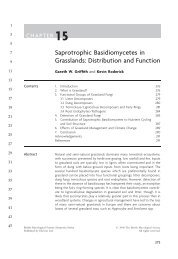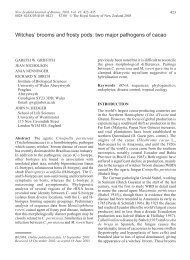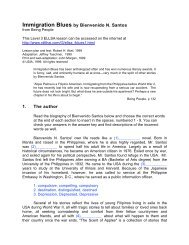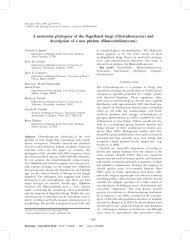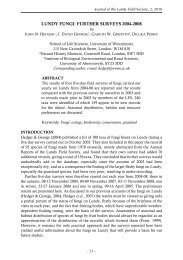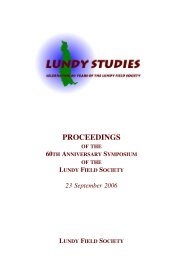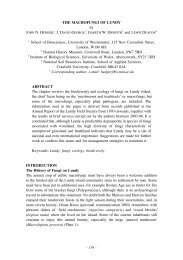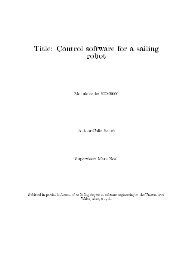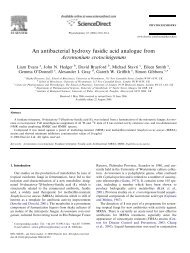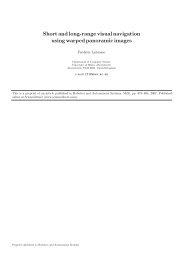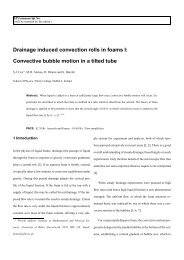Anaerobic rumen fungi
Anaerobic rumen fungi
Anaerobic rumen fungi
Create successful ePaper yourself
Turn your PDF publications into a flip-book with our unique Google optimized e-Paper software.
Agriculturally Important Microorganisms Vol. II<br />
Rumen anaerobic <strong>fungi</strong> actively colonize plant cell walls and account for up to 8-12% of the<br />
microbial biomass in <strong>rumen</strong> (Rezaeian et al. 2004). Prior to their discovery, it was assumed that<br />
only <strong>rumen</strong> anaerobic bacteria and protozoa were involved in hydrolysis of plant biomass. But<br />
now, it is well established that these ruminal <strong>fungi</strong> effectively take part in fibre digestion in<br />
ruminants (Dey et al. 2004, Lee et al. 2004). The rhizoids of their vegetative thalli penetrate deep<br />
into plant tissues better than bacteria and protozoa, and thus achieve access to plant materials<br />
otherwise unavailable to other <strong>rumen</strong> microorganisms. This infiltration leads to a more rapid<br />
degradation of forage entering the <strong>rumen</strong> (Orpin and Joblin, 1988; Nagpal et al. 2007b). These<br />
<strong>fungi</strong> secrete high levels of very active fibre-degrading enzymes (cellulases, hemicellulases,<br />
xylanases, avicelases, glycosidases etc.) found to be associated with rhizomycelia (Williams et al.<br />
1994; Lee et al. 2001).<br />
2. HISTORICAL MILIEU<br />
The ruminal anaerobic <strong>fungi</strong>, reported as early as 1910, were thought to be flagellate protozoa<br />
(Liebetanz, 1910; Braune, 1913) and placed in the genera Callimastix, Sphaeromonas and Oikomonas.<br />
These flagellates were recognized as <strong>fungi</strong> for the first time in the 1970s (Orpin, 1975) with the first<br />
named species Neocallimastix frontalis. The flagellate zoospores encyst and germinate on ingested<br />
forage with radiating rhizoids that produce a single zoosporangium. In terms of lifecycle and<br />
morphology, N. frontalis is similar to members of Chytridiomycota and its fungal affinities are<br />
confirmed by chitin in the cell wall (Orpin, 1975); though uniquely among the <strong>fungi</strong> it is an<br />
obligate anaerobe. About twenty different species of anaerobic <strong>rumen</strong> <strong>fungi</strong> have been reported<br />
in various ruminant and hindgut-fermenting mammals. It is established that removal of these<br />
<strong>fungi</strong> from the <strong>rumen</strong> results in a significant diminution in in-vitro gas production and<br />
degradation of fibrous feeds, signifying a vital role such <strong>fungi</strong> play in fibre degradation (Lee et al.<br />
2004). The enzyme profiles of various <strong>fungi</strong> studied indicated secretion of a wide range of lignocellulolytic<br />
enzymes. Scanning electron microscopic studies ascertained that these <strong>fungi</strong><br />
preferably attach to most lignified tissues of plant feed (Akin, 1987). Hence, fibre-based diets<br />
stimulate their proliferation in the <strong>rumen</strong> compared to diets rich in easily fermentable<br />
carbohydrates (Paul et al. 2003). Pelleted diets generally have a shorter transit time through the<br />
gastro-intestinal tract and therefore do not support good anaerobic growth of <strong>rumen</strong> <strong>fungi</strong> in-situ.<br />
High soluble sugar content inhibits germination of fungal zoospores on plant tissues (Roger et al.<br />
1992), and this might be due to lowered pH of <strong>rumen</strong> liquor (Orpin, 1977).<br />
3. TAXONOMIC STATUS<br />
<strong>Anaerobic</strong> zoospore-producing <strong>fungi</strong> are very recently assigned to Chytridiomycota, a basal<br />
group within kingdom Fungi and subdivided into five orders i.e., Blastocladiales,<br />
Monoblepharidiales, Chytridales, Spizellomycetales and Neocallimastigales (Barr, 1990). Based<br />
on the ultrastructural characteristics of zoospores, anaerobic <strong>fungi</strong> were originally placed in the<br />
order Spizellomycetales (Barr, 1980; Barr and Desaulniers, 1988) but later transferred to a separate<br />
order (Neocallimastigales) by Li et al (1993). The precise relatedness of the Neocallimastigales to<br />
other chytrid <strong>fungi</strong> is at present unclear since they possess a number of features not common with<br />
other chytrid taxa (hydrogenosomes, polyflagellate zoospores, distinctive flagellar attachment;<br />
Barr, 1990; James et al., 2000), and are distinctive in other respects too (e.g. very high AT [ca. 70%]<br />
DNA base ratio; Brownlee, 1989). The recent international collaborative effort (AFTOL project: All<br />
Fungus Tree Of Life; http://aftol.org/) to establish a multiple gene genealogy for kingdom Fungi<br />
found Chytridiomycota to be polyphyletic (with loss of flagellate zoospores on several occasions)<br />
but confirmed anaerobic <strong>fungi</strong> basal to the 'core' chytrid clade (James et al., 2006a; b). On the basis<br />
376



